!!! My website has
moved: please update your bookmarks to debunix.net !!!
Musings on the genetics of small
populations of killifish
Start with an example of crossing two individuals, each of whom
carry a lethal recessive version of one of two different genes, gene A
and gene B. A and
B represent the good copies of
the gene; a and b represent the bad copies of each gene.
Each individual requires at least one good copy of each gene to
survive. If he has one A
and one a, he's fine. If
he has AA, he's fine. If
he has two aa, he's
dead. So having a A
trumps, or is dominant to a, and a is recessive to A, and is recessive lethal because individuals having
two a versions of the gene
are dead. And ditto for the B gene.
The parents being crossed are the first line of each table;
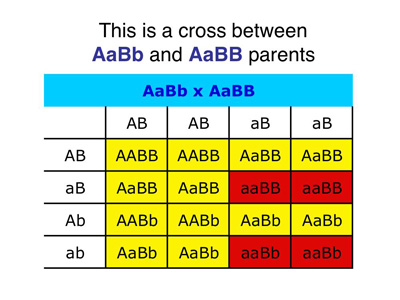
the possible combinations of genes that they can give to their
offspring are shown on the edges;
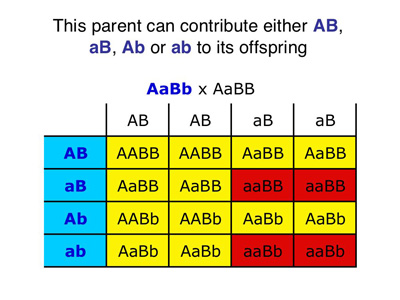

the genotypes of the possible offspring are the shown in the colored
squares:
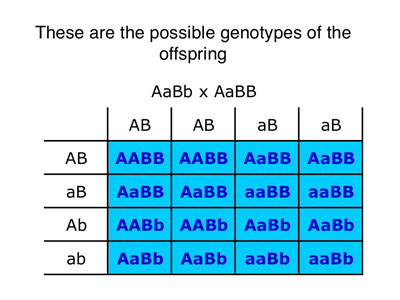
There are duplications to represent the true frequency of each
potential cross and offspring, to give a visual representation of the
true frequencies of each possible combination.
In this example, the yellow squares represent viable offspring
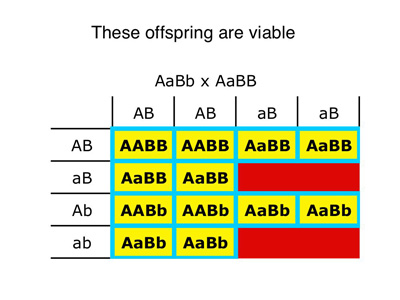
the red
squares represent non-viable offspring (they lack a good copy of A or
of B).

In the F1 generation, all the offspring are viable
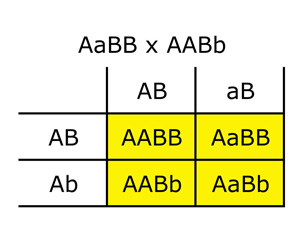
In the second generation, there are 16 possible matings--each of the F1
can mate with another individual of the same genotype, or each of the
other three genotypes, four options for each of the four offspring,
totalling 16 possible mating combinations. I am including the
duplicates possibilities to give a visual representation of the
relative odds of each combination occuring. In this
example, 31 of 256 potential F2 offspring are not viable.

So if only 31 are not viable, that means 225 are viable, no problem,
right?
But what you happened to pick these two F1--since they all look equally
healthy--to produce the next generation?
Female AaBb
Male AaBb
Now your next generation looks like this:
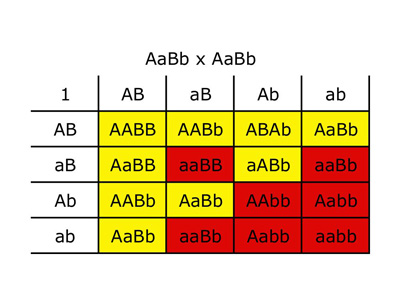
Now 7/16--44%--of the offspring are not viable.
But of course, I've stacked the deck in this example, right?
There's only a 1/16 chance you'll happen to pick that pair (or get only
those two genotypes by chance). 15/16 of the time you'll get a
higher proportion of viable offspring. Heck, there's an equal
(1/16) chance you'll pick AABB x AABB for the next generation, and if
you did that, then you would have eliminated the bad a and b gene
versions from your future stock completely with this one choice.
Here's where it gets tricky, though: it's very likely that that
founders carry bad copies of more than two genes with somewhat
deleterious effects on their offspring. And the more
deleterious copies of genes in your original stock, the higher the
proportion of the next generation that will end up with a two bad
copies of at least one gene. Here's an example of a cross between
fish that each carry a bad version of three different genes:

Only 27/64 from this cross are viable, vs 9/16 in the previous
example.
And while I've again cherry picked to this example--picking the triple
heterozygote parents for the sample F1 cross that yields the lowest
proportion of viable offspring--the simple point that I'm trying to
make is that, when your population is small, generation after
generation, you have a high risk of losing the line through bad luck in
the genetic lottery. And the more bad alleles you start out with
in the F0 founders, the worse the problem is. Throw in some
neglect here and there, unequal sex ratios, and no wonder it's hard to
keep a line going--unless you have the luxury of keeping lots of fish
every generation.
Even in a relatively small population in the wild, you're likely to
have tens or hundreds of individuals contributing to the next
generation, so the line continues. And most deleterious mutations
aren't 100% normal as heterozygotes and 100% lethal as homozygotes, so
there is some viability difference for natural selection to act upon to
gradually eliminate the deleterious versions from the gene
pool.
But in a tank, where predators are few and food is abundant, you don'
have this degree of selection. You can try to pick the healthiest
looking fish, with the brightest colors and largest size as external
indicators of robust genetics, but not all the deleterious genes have
visible effects. You're not likely to select as strictly as life
in the wild will. This lack of strict ongoing selection compounds
the problem of a small gene pool, and increases the odds that, by
chance, your stock may gradually end up with higher proportions of bad
genes, and getting sicklier and sicklier, until it peters out.
I'd argue that the people who get 20 generations from a single founding
pair probably got lucky, happening to end up with breeders in
subsequent generations with a higher proportion of the best versions of
their genes--maybe helped along by some good deliberate selections, and
also were diligent in avoiding the neglect that leaves you with only
one possible pair of breeders to restart the line.
Back to
Fish Page
Return to Diane's Home Page









